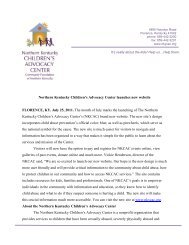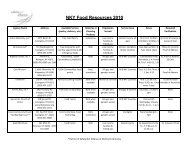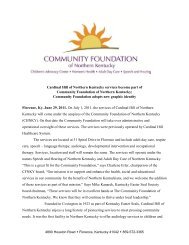Medical Research: A Consumer's Guide for Participation
Medical Research: A Consumer's Guide for Participation
Medical Research: A Consumer's Guide for Participation
Create successful ePaper yourself
Turn your PDF publications into a flip-book with our unique Google optimized e-Paper software.
II.<br />
The Basics of <strong>Medical</strong><br />
<strong>Research</strong><br />
A. Translational vs. Clinical <strong>Research</strong><br />
Volunteers can take part in two types of medical<br />
research: translational and clinical. The participation<br />
of volunteers is critical to the success of both types of<br />
research.<br />
1. Translational <strong>Research</strong><br />
Translational research is often referred to as “bench<br />
to bedside” research because it tries to take the discoveries<br />
that were made in the laboratory and apply<br />
them to humans (clinical application). Translational<br />
research uses tissues and body fluids from volunteers<br />
so that scientific discoveries can be applied to medical<br />
conditions. For example, a newly discovered receptor<br />
(the part of a cell that binds to certain types of molecules)<br />
in skin or saliva may play a role in cancer. By<br />
studying tissue and body fluids that do or do not<br />
contain that receptor or substance, the researcher can<br />
begin to discover whether or not there is a link with<br />
cancer.<br />
Scientists study both healthy and diseased tissue, often<br />
using tissue that is left over after a medical procedure.<br />
Studying healthy tissue helps scientists understand<br />
how normal cells work and what effect substances like<br />
drugs and chemicals may have. Studying a removed<br />
tumor helps researchers understand the properties of<br />
cancer cells and improve treatments. Tissue research<br />
also reveals new ways to diagnose health problems<br />
through biomarkers which are molecules in the blood<br />
that indicate health or illness. For most translational<br />
research, there is no direct risk to research volunteers.<br />
Tissue research in the area of genetics—the study of<br />
proteins or genes that affect cell development—is critical.<br />
It helps scientists learn how certain proteins or<br />
genes affect detection, diagnosis, or response to treatment.<br />
It also sheds light on the development of<br />
diseases that are passed from parents to children.<br />
Some doctors and scientists believe that many diseases<br />
have a genetic basis. If this is true, it might explain<br />
why medicines work well in some patients but do not<br />
work in others. Improved understanding of the role<br />
of genetics in health and illness may someday lead to<br />
medicines that are tailored to match the patient’s<br />
genetic code.<br />
Removed tissue may be studied immediately or be<br />
frozen or preserved <strong>for</strong> later use. Frozen tissue is<br />
stored in a tissue bank, also known as a biorepository.<br />
The stored tissue is identified by a number or code,<br />
not by the research volunteer’s name. However, some<br />
clinical or medical in<strong>for</strong>mation about the volunteer<br />
may be included to help researchers understand<br />
experiment results. This in<strong>for</strong>mation can include<br />
general health and past or current medical treatments.<br />
Sometimes, additional in<strong>for</strong>mation about the<br />
volunteer’s health is collected <strong>for</strong> years after the<br />
volunteer has donated her tissue <strong>for</strong> research.<br />
Scientists study this in<strong>for</strong>mation to better understand<br />
changes related to the aging process, health status<br />
and treatments the person has undergone.<br />
<strong>Research</strong>ers collect tissue <strong>for</strong> research according to a<br />
document called a protocol. The protocol describes<br />
in detail the research design and how the study will<br />
proceed. For tissue research, the protocol describes<br />
how donations will occur, the type of tissue that will<br />
be collected, how the tissue will be preserved, and the<br />
research that will be per<strong>for</strong>med. In most cases,<br />
in<strong>for</strong>med consent will be required. In<strong>for</strong>med consent<br />
refers to the agreement of a person to take part in<br />
research after being told about its risks, potential<br />
benefits, and alternatives. In other words, the<br />
researcher asks permission to collect and study a<br />
person’s tissue or bodily fluids. A <strong>for</strong>m is used to<br />
record this in<strong>for</strong>mation, which describes the type of<br />
research that will be per<strong>for</strong>med and explains a participant’s<br />
right to revoke consent and end her participation.<br />
A volunteer always has the right to revoke<br />
consent. In some cases, the volunteer’s tissue may be<br />
removed from the research study but in others,<br />
because of the way the tissue is stored, the tissue<br />
remains in the study but no more in<strong>for</strong>mation about<br />
the volunteer is collected.<br />
A protocol is also usually developed so that tissue<br />
from a tissue bank can be used. The protocol will<br />
describe the plan <strong>for</strong> research using the tissue. Often,<br />
the in<strong>for</strong>med consent that is used to collect tissue<br />
allows the tissue to be used <strong>for</strong> any kind of research.<br />
Sometimes, however, the in<strong>for</strong>med consent will limit<br />
the kind of research that can be done. <strong>Research</strong>ers<br />
respect these limitations. To protect research volunteers,<br />
a group of people called an institutional review<br />
board (IRB)at the research institution conducting the<br />
research will review and approve the protocol.<br />
2. Clinical <strong>Research</strong><br />
In clinical research, doctors and scientists test new ideas<br />
about ways to prevent, diagnose and treat diseases.<br />
Another name <strong>for</strong> clinical research is clinical trial. In<br />
clinical trials, a drug, medical device, biologic (e.g.,<br />
vaccine), blood product, gene therapy or surgical<br />
procedure is tested to answer the following questions:<br />
4
















